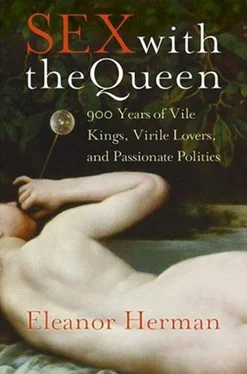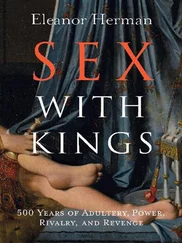It would have been a great consolation for a royal bride trapped in a loveless marriage, with no control over her children, to have at her new court beloved childhood friends from her old one. But in many cases such friends were abruptly sent home or were not permitted to come in the first place.
The princess bride usually arrived with a large retinue of servants all hoping to take up plum positions at her new court. And, indeed, her home court was eager to surround her with as many compatriots as possible to influence her on behalf of her native land. As for the bride herself, she was glad to see familiar faces and speak her mother tongue. But this influx of outsiders caused ill will in her new country from courtiers unwilling to see their remunerative positions go to babbling foreigners.
In 1600 Princess Marie de Medici of Tuscany, the bride of Henri IV, arrived with a throng of Italians itching to be awarded positions at the French court. But the king’s minister, the duc de Sully, vowed he would recommend “neither a doctor nor a cook.” Those already holding offices at court protested that “the bread would be taken from their mouths,” he said, citing that “in France there are vested interests.” 32
When the fourteen-year-old French princess Elizabeth of Valois married thirty-two-year-old Philip II of Spain in 1559, she arrived in Madrid with a large flock of noble ladies who expected to serve as her ladies-in-waiting. They squabbled constantly with the queen’s Spanish ladies-in-waiting, who felt threatened by the intruders. The king wanted to send home all the arrogant French ladies but had a hard time dealing with his young bride’s tears. Finally, he allowed them to stay as her friends, but announced that French subjects could not hold official positions at the Spanish court. Her ladies erupted in a flurry of complaints and reproaches, and some indeed went back to France. Those who remained were accused of alienating the queen from her new country; they kept her surrounded by French language and customs so she did not learn Spanish words and ways; furthermore, they prevented her from becoming close to her Spanish ladies.
The duque de Alba, majordomo of the queen’s household, looked at her French ladies as vile interlopers and hoped to insult them so irrevocably that they would all leave voluntarily. He assigned one lady in delicate health, Mademoiselle de Montpensier, a French princess of the Blood Royal, a cheerless chamber without a fireplace so she suffered dreadfully from the cold. There were stories that he tried to prevent her from riding in the queen’s coach, that he even grabbed the train of her gown and dragged her from the carriage as she fought him off with punches and kicks. On another journey he pulled the cushions from under her in the royal litter to make her ride intolerably uncomfortable. The government of France was furious.
Such disputes convinced many courts that, in the interest of international relations, no foreign bride should be permitted to bring with her a single lady. No childhood friends, no familiar faces, no one to speak her own language in a familiar accent. In 1893 Crown Princess Marie of Romania was not allowed to bring ladies from her native England. Neither was she permitted to make Romanian friends. The curmudgeonly King Carol was afraid that she might ally herself to one political faction or another at court, and therefore forbade her any society at all.
Living in a kind of prison in her rooms, Marie described her life as “cramped, lonely, and incredibly dull.” 33Rarely permitted to attend state functions, balls, operas, or parties, Marie found herself bored to death, surrounded by hawkeyed servants who spied at keyholes, fished papers out of her trash bin, and reported her every word and action to the king. When Marie complained, old King Carol informed her that members of a royal family should have no expectation of personal happiness.
If the princess bride felt lonely and unhappy at her new court, she was in no position to visit her family back home. Travel was strenuous and often dangerous. Carriages, without benefit of springs, jolted mercilessly over rutted roads. When it rained, wheels stuck in morasses of mud; when it didn’t, dust coated passengers from head to toe. Many roads were too atrocious to permit the use of carriages, and travelers, even the old and ailing, were forced to mount mules. Roadside inns were so riddled with filth and insects that well-heeled travelers carted their own beds, sheets, and armchairs with them.
Even sea travel had its difficulties. Sailboats were pitched about by storms which strained the rigging and sometimes snapped the masts. Even the noblest travelers heaved up their meals into the deep blue sea. Periodically the lack of wind was a problem—ships were becalmed for weeks on end while passengers cooled their heels. Pirates cruised the ocean blue ready to swoop down upon unsuspecting vessels. In 1149 Eleanor of Aquitaine, queen of France, was captured by Byzantine pirates on her return from the Crusades and held prisoner until warships came to her rescue. In 1784 Aimée de Rivery, a cousin of Josephine, the future empress of France, was captured by North African pirates and sold into the Sultan’s harem in Istanbul from which she never emerged.
Pirates aside, even legitimate navies posed a threat. The shifting balance of European power often meant war or threats of war, and royalty would make valuable hostages. In 1795 French warships hoped to capture Princess Caroline of Brunswick on her way to marry George, Prince of Wales. When the British squadron sent to defend her became stuck in the ice, Caroline had to backtrack and wait for warmer weather. Her weeks of boredom were punctuated by the booming of cannon fire in the distance.
Not only was travel difficult and dangerous, but those willing to endure the hardships of the road or sea usually found that the demands of royal protocol were more aggravating than the trip was worth. For several years after her 1559 marriage to King Philip II of Spain, Elizabeth de Valois longed to visit her mother, the French queen regent Catherine de Medici, and her younger brother, King Charles IX, who were, after all, just across the border.
After much wrangling among diplomats, ministers, and both royal families, it was decided that the reunion of mother and daughter would be held in June 1565. The first debate centered on the location. The French did not want to demean themselves by crossing the Spanish border, using the excuse that out of respect the daughter should travel farther to visit her mother. Similarly, the Spanish believed that their nation’s prestige was far greater than that of France, so the French court should cross the border into Spain. The town of Bayonne, just over the Spanish border, was finally agreed upon.
On both sides, the selection of courtiers for the voyage was hotly contested; men unsheathed their swords to win this great honor; women unsheathed their claws. In both Spain and France, there was much slashing and shredding. Ladies pleaded the honorable positions they held in the royal household, while men trumpeted the battlefield feats of their ancestors. Tears were shed, sobs erupted, and finally a list was assembled that delighted some and outraged others.
The next question was one of wardrobe. Each court wanted to outdo the other in its magnificence. But Philip told the queen’s ladies that Elizabeth “deprecated foolish and extravagant expenditure on the occasion, and that she considered the robes, which the ladies of the household ordinarily wore, were costly and magnificent enough, and ought to be worn full nine months longer.” He prevented his courtiers from ordering new gold and silver embroidered equipment for their horses, and “hoped that in France they would act on the same principle, in order that a meeting, which was planned for pleasure, and not for ostentatious display, might not give occasion for grievous expenses.” 34
Читать дальше












